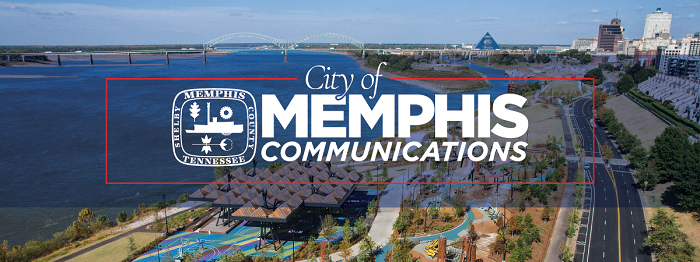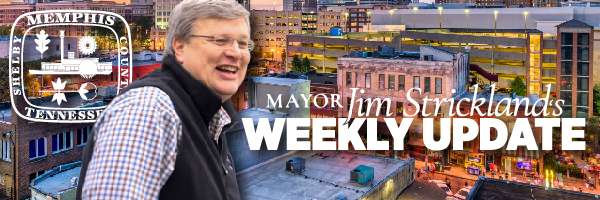Weekly Update: 2020 Census
Memphis sent this bulletin at 08/20/2021 03:25 PM CDTFriends,
For years, I’ve said population loss is one of the main challenges facing our city. For at least the last 50 years, more people have been moving out of Memphis than moving in, and the most recent Census data still confirms that notion.
As you may have seen, the city’s population dropped 2.2 percent from 646,889 in 2010 to 633,104 in 2020. In my opinion, historically that loss has largely been driven by two factors—crime and schools.
While I am not satisfied with these Census results, I do want to note that the rate of loss is lower than it has been in recent decades. Between 1980 and 2010, 120,000 people left our city.
Let me explain the calculation.
The Census in 1980 and 2010 show almost identical numbers for Memphis (just shy of 650,000 people), but during those 30 years, Memphis annexed areas containing 120,000 people. Without any exodus, Memphis’ population in 2010 would have been roughly 720,000 with those annexations.
When I took office in 2016, I took actions to: improve city services, grow job opportunities, implement universal pre-kindergarten, lower crime and improve the quality of life for all Memphians—in part to try and reverse our history of population loss. I have written about these topics many times before.
But, today, I want to highlight three specific actions—Memphis 3.0, continuing to rebuild MPD, and increased opportunities for young people.
First, we have completed and have been implementing Memphis 3.0—the city’s first comprehensive plan in over 40 years. The plan was drafted with input from 15,000 Memphians who came up with plans on what their neighborhoods should look like over the next 10-20 years. For too long, the city tried to annex its way into increased population, but ultimately just added to the city footprint without adding density. Not a sustainable model.
Since becoming mayor, I have often said the phrase “build up and not out”. Memphis 3.0 is a roadmap for doing just that.
The whole concept of Memphis 3.0 is based on creating density with a focused approach on certain areas of our city. Since July of 2016 through June of 2021, over 7,200 new dwelling units have been constructed in the core of our city. Of that 7,200, nearly 5,500 units have been constructed in Anchor areas as defined by Memphis 3.0. In addition, we have incentivized the rehabilitation of 9,780 units into quality, affordable housing.
To go a step further, we are investing $200 million through our Accelerate Memphis plan into previously overlooked areas and parks in our core neighborhoods as outlined in Memphis 3.0.
Second, we’re working our public safety plan every single day. The plan is based on best practices in Memphis and other cities from around the country, and we now have a Group Violence Intervention Program (GVIP) as an additional complement.
My other parts of the plan can be summarized in five points:
- Rebuilding MPD. Since we’ve taken office, and in partnership with the City Council, we’ve increased funding for the Memphis Police Department and improved the pay (a two percent pay raise and a nine percent bonus are in the FY22 budget), and improved benefits and promotions for our officers to better recruit and retain them.
- Punishing violent offenders. While there’s no question that we should explore alternatives to prison for non-violent felons, there’s also no question that we should prosecute violent criminals to the fullest extent of the law. We have worked with the state to strengthen penalties for gun crimes and domestic violence, as well as strengthened our partnership with the U.S. Attorney to increase prosecutions of violent gun crimes in the tougher federal system.
- Positively affecting more young people. The true long-term solution to crime is young people picking the right path instead of the wrong one. Young people need something productive to do when they’re not in school. Prior to the pandemic, we had greatly increased those activities. We had increased by 100 percent the number of youth summer jobs compared to when we took office, and we worked with the private sector to create even more. Youth library programming and parks youth athletics participation had more than doubled, and more youth are using our community centers. And while it is certainly a long-term investment, we funded universal, needs-based Pre-K for the first time in City history.
- Reducing recidivism. We have expanded programs that work to connect local employers with individuals who have paid their debt to society and are leaving prison. We raised private funds to pay for the expungement fees for hundreds of non-violent felons and have lobbied to have those fees reduced. It is vitally important that ex-felons have the opportunity to become productive members of society, or else, as statistics show, they are more likely to commit crimes again.
- Increasing economic opportunity. At City Hall, we have worked hard to create an environment in our city to enable the private sector to invest more and more, and we’ve worked to overhaul how our community attracts new jobs. Data shows that pre-pandemic 20,000 more Memphians were working at the beginning of 2020 than when I became mayor in 2016.
Third, and in addition to what we’re already doing for youth as mentioned above, I wrote a few weeks ago about our proposal to allocate $9 million of ARPA funds over three years to the Boys and Girls Clubs of Greater Memphis. These funds would expand on a program at Craigmont High School that Superintendent Dr. Joris Ray and BGCM have been successfully operating over the last three years.
Quick BGCM stats:
- 100 percent of seniors graduate, and 100 percent of graduates go to college, get a job, or join the military.
- 76 percent of low-income club members ages 12-18 who attend regularly reported receiving mostly A’s and B’s, compared to 67 percent of their peers nationally.
- 81 percent of BGCM members show an increase in homework completion.
- 57 percent of alumni said the club saved their life.
- The percentage of Club girls who express an interest in a STEM career (47 percent) is more than three times greater than that of their same-aged female peers nationally.
With sufficient funding, BGCM can have a transformative impact on our young people.
All that to say—yes, we have had some slight population loss.
But, we have been and are continuing to take actions that will put our city on the path for future growth. I am a firm believer that our brightest days are yet to come, and we’re working every day to make sure that becomes a reality.
Yours,



